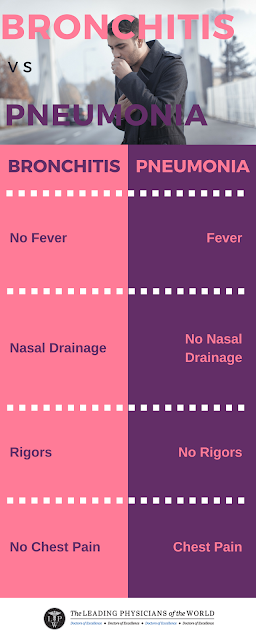Bronchitis vs Pneumonia
Bronchitis
and Pneumonia are confused very often because they cause incredibly similar
symptoms. A cough that lasts for weeks or even longer are symptoms of both
illnesses. However, there are some crucial differences between these illnesses
that you need to know about. If you have ever been diagnosed with either one or
know someone who has, you'll want to know how they differ. Learning the most
important differences between bronchitis and pneumonia is crucial to help you
come up with an effective treatment plan. Bronchitis occurs when the lining of
the passages that carry air to and from your lungs, known as your bronchial
tubes, becomes infected.
Bronchitis
The less serious
of the two, bronchitis is caused by inflammation of the bronchi, the branching
tubes that deliver air into the lungs. The most common symptoms of bronchitis
include:
●Coughing with clear, yellow or
green sputum (the gunk you cough up)
●Fatigue
●Wheezing
●Runny, stuffy nose occurring before
chest congestion begins
●Shortness of breath, usually
following a coughing jag
●Mild fever
Although
yellow or green sputum is often thought to indicate bacterial infection, don't
be fooled."Over 80 to 90% of bronchitis in healthy people is viral, not
bacterial, in origin, especially if the symptoms of bronchitis follow a
cold," says Homer Boushey, M.D., a lung specialist and professor emeritus
of medicine at the University of California, San Francisco.
Viral
infections cannot be treated with antibiotics. In fact, says Boushey, antibiotics
will kill many of the healthy, protective bacteria in your body. "That
leaves you more susceptible to disease-causing bacteria."Acute bronchitis
will most often go away on its own within a week to 10 days, though your
mucus-y cough will likely persist for several more weeks."It's just a
matter of the body cleaning up the mess," says pulmonologist Len Horovitz,
M.D., of Lenox Hill Hospital in New York. "Most people recover just fine
from bronchitis."
Pneumonia Symptoms
Pneumonia
isn’t a bad case of bronchitis like many people think. This illness is an
infection located inside one or both of your lungs. If your doctor diagnoses
you with pneumonia, he or she may tell you that you have either bacterial
pneumonia, viral pneumonia or mycoplasma pneumonia. Here’s what those symptoms
look like:
●In bacterial pneumonia, patients
usually develop a high fever with possible shaking chills. You may also
have moderate or severe chest pain when you cough or draw in a deep
breath. The cough produces thick phlegm that is green, yellow or rust-colored.
●Viral pneumonia’s symptoms are like
those of the flu: You’re feverish and headachy. You have muscle aches and
a dry cough. You feel very weak. What makes viral pneumonia different from the
flu is that, within 12 to 36 hours of getting sick, you become short of breath
and your cough is slightly productive. Your temperature may go up and breathing
may become even more difficult – to the point where your lips take on a bluish
tinge.
●Mycoplasma pneumonia or “walking
pneumonia,” doesn’t make you very sick. Your symptoms develop over a few weeks,
with headache, fever, fatigue and a cough. You should see your doctor if your
fever is high, if you have shaking chills, your cough won’t let you sleep at
night, you keep bringing up phlegm, wheeze or feel chest pain during coughing
or when you pull in a deep breath.
Although
bronchitis and pneumonia both cause coughs and can develop after more common
illnesses such as the common cold or flu, they are slightly
different. Only your healthcare provider can diagnose your illness and
determine which treatment is right for you at the given time. If you have a
lingering cough or any of the other symptoms listed above, make an appointment
to see your doctor and get some answers to relieve your stress and all
following symptoms.




Comments
Post a Comment